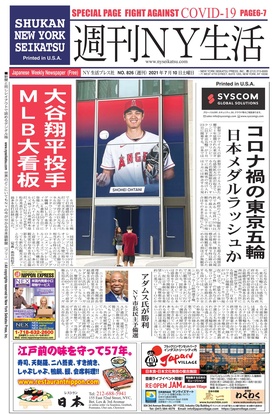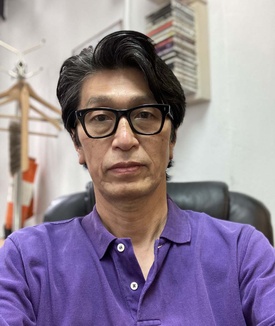As long as there are readers
Weekly NY Life, a Japanese publication with a circulation of 20,000 copies on the East Coast of the United States, mainly in New York, was launched in 2004. People who have lived in the United States for a long time may be surprised that the paper has been around for less than 20 years. I am one of them. The reason is that both the publisher and CEO of the magazine, Ryoichi Miura, and the president and COO, Shigeru Hisamatsu, are from Yomiuri America, which was published in the United States, so the impression of Yomiuri America is strongly felt. In the 1990s, I enjoyed reading the wide variety of articles in Yomiuri America, which were sent to my workplace every week, covering everything from lifestyle information to entertainment and trends in the United States.
Miura, who agreed to be interviewed this time, left the Los Angeles economic newspaper where he had been working when Yomiuri Shimbun published its US local edition (later called Yomiuri America, and called New York Yomiuri at the time) in 1985, and worked as a reporter in the editorial department and then as a desk editor at Yomiuri America until it closed in 2003. However, when it was decided that Yomiuri America would close, he said that he wanted to "deliver a Japanese-language information paper while there were still readers," and so he started a business with Hisamatsu.
"Apart from changing from a large-format newspaper to a tabloid version, the content of Weekly NY Life follows that of Yomiuri America. Our readers are a mix of expatriates, international students, and permanent residents. In that respect, there were a lot of Japanese Americans on the West Coast where I used to live, but in New York, you hardly ever see anyone of Japanese descent. As a result, many of our readers will eventually return to Japan, so articles related to education, such as entrance exams for returning to Japan, are popular. Other articles that attract attention are those related to visas and health. The key is to provide information that readers need, but that is not covered in English media like the New York Times, and information that cannot be read in Japanese. To do this, we research and write even the smallest articles ourselves. Our strength is that we publish original articles that readers won't see anywhere else, and it's not rare for major Japanese media to contact us after reading our articles," says Miura, showing his confidence in the "original reporting" of Weekly NY Life.
So I asked how many people were doing the reporting, and he replied, "We have four or five external writers helping us, but I'm the only one working full-time." Hearing this, "Of course, I'm not doing it all by myself. We have two sales people, but they're currently working remotely, so I'm the only one who goes to the office in Manhattan. In addition to reporting, writing, and editing, we also have to be present at the printing company. In addition, the sales manager and I are in charge of deliveries within Manhattan," the phrase "a select few" came to mind.
In the future, "options for retirement"
Next, I asked about the motto behind the layout of the pages of Weekly NY Life.
"Our mission is to report what has happened as quickly and accurately as possible. In addition to new information that 'must be reported,' we also publish information that 'will make our readers happy by reading it.' The latter includes interviews with people who have become famous in America, or people who are unknown now but are likely to become famous in the future. I said that we aim to do so as quickly and accurately as possible, but since it's a weekly publication, it's not as fast as a daily. However, through the 35 or 36 years I've been working in this job, I've always been involved with weekly newspapers. The rhythm of printing on Wednesdays and publishing on Thursdays is ingrained in me. To be honest, even if we were to change the schedule to something else, I don't know what to do (laughs)."
When asked about the difficulties of continuing publication, Miura, who is both the editor-in-chief and publisher, responded as follows:
"The key to success is advertising revenue. Our clients, such as agencies and hotels that handle travel between Japan and the US, have had a tough time during the pandemic. But once the coronavirus is contained, business will pick up again. We will likely have to advertise again asking people to use our services. Our mission is to continue publishing in preparation for that time."
Do you have any plans to start any new projects in the future?
"As our readers get older, more and more will be returning to Japan (repatriating). We will focus on providing information that will be useful for those returning home, as well as information for readers overseas who are worried about their Japanese parents entering a nursing home, even if they haven't yet. We will also cover the options available to those who may spend their retirement in the United States. We have actually received requests from readers to do so."
Regarding returning to Japan, an online seminar titled "Hometown Project" has already been held.
We asked Miura, who has been working for an economic newspaper for over 40 years, about the rewards of being an editor, delivering information in Japanese to people living in America.
"It's the joy of communicating. That's what keeps me going. By conveying information through the pages of a newspaper, I'm sure it can help some people, make them happy or sad, and also make them feel a sense of connection with society. So, rather than being motivated by my own work, my motivation comes from the joy I get from seeing readers read my work."
Those words resonated deeply with me as a writer whose job is to "communicate."
* The official website for the digital edition of "Weekly NY Life"
© 2021 Keiko Fukuda








